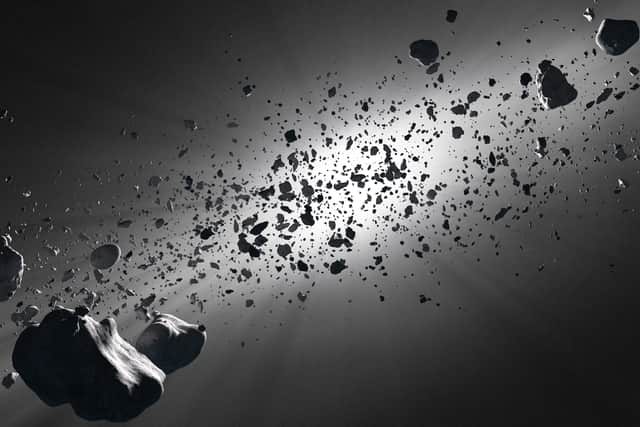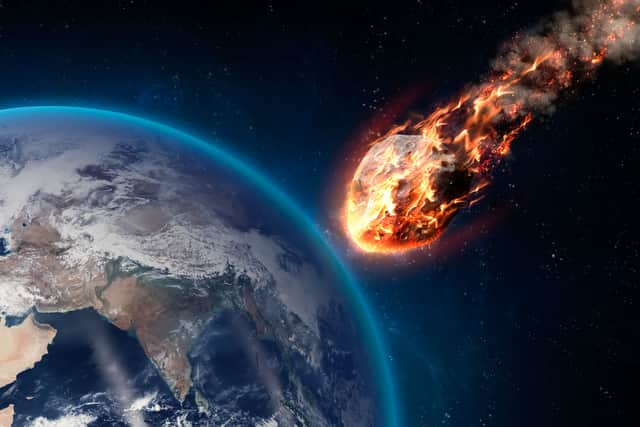Asteroid 2022: how big is Nasa tracked asteroid which passed Earth, and could it hit our planet in the future?
and live on Freeview channel 276
Life on earth is in a particularly precarious position at the moment, what with the increasing tally of extreme weather events caused by climate change and the very real prospect of another world war beginning in Ukraine.
It’s easy to forget that threats to our existence don’t just exist here on earth, but are also coming at us from outer space.
Advertisement
Hide AdAdvertisement
Hide AdIn December 2021 our planet had a ‘near miss’ with the asteroid 4660 Nereus, which was then followed by an even closer encounter with another space rock in the New Year.
Asteroid 7482 (1994 PC1) - a rock larger than any building on earth - only narrowly missed us on 18 January.


While Nasa has begun work to see if we can stop asteroids from crashing into earth, the US space agency reckons it has only mapped about half of the big asteroids out there.
So how close did asteroid 7482 (1994 PC1) come to causing Armageddon, will it threaten us again - and what is Nasa doing to reduce the threat from asteroids?
Here’s everything you need to know.
Will a massive asteroid hit earth in 2022?
Advertisement
Hide AdAdvertisement
Hide AdThe asteroid 7482 (1994 PC1) came within an astronomical whisker of earth on 18 January.
But a near-miss in space terms wouldn’t be considered close at all by most people’s standards.
The space rock zoomed past us at a distance of more than 1.2 million miles - roughly five times the distance between the earth and the moon.


This is half the distance at which 4660 Nereus passed the earth in December.
Advertisement
Hide AdAdvertisement
Hide AdWhile that’s probably close enough for your liking, asteroid 7482 (1994 PC1) has come much closer to earth in the past.
In 1933, the asteroid shot by at a distance of only 700,000 miles.
4660 Nereus is set to come within a similar distance of us on Valentine’s Day 2060.
How big is the asteroid?
At more than a kilometre in diameter (1,052m) and travelling at almost 44,000 miles per hour, the space rock has the potential to destroy life as we know it here on earth.
Advertisement
Hide AdAdvertisement
Hide AdDue to it being over 140m in size, Nasa classifies asteroid 7482 (1994 PC1) as a “potentially hazardous” near-earth object.


It is also defined this way because its orbit has and will cause it to come within less than half the distance from the earth to the sun - roughly 93 million miles.
This means that any slight deviation in its orbit could put it on a collision course with us.
As things stand, asteroid 7482 (1994 PC1) is not predicted to come as close to the earth again until at least 18 January 2105.
Advertisement
Hide AdAdvertisement
Hide AdOther space rocks are set to come even closer in the meantime, but other asteroids or comets could well come out of nowhere.
While Nasa says there is no “significant chance” any of the more than 10,000 asteroids over 140m in size it has come across will hit the earth in the next 100 years, it’s estimated these figures account for just half of the potentially deadly objects out there.
In fact, there could be more than 25,000 near-earth objects in space, meaning we are tracking less than half of the killer asteroids out there.
What is Nasa doing to stop asteroids or comets hitting earth?
Work to save humanity from death by asteroid is still very much in its infancy.
Advertisement
Hide AdAdvertisement
Hide AdNasa has only been tracking near-earth asteroids full-time through its Centre for Near-Earth Object Studies since 1968.
And it only launched its first exploratory mission to see how easy it is to knock an asteroid off course in November 2021.


The space agency’s Double Asteroid Redirection Test (Dart) mission will see a spacecraft smash into a harmless Nasa-tracked asteroid in a bid to alter the space rock’s course.
If it succeeds, humanity might have discovered a way to keep itself safe from a future deadly impact.
Advertisement
Hide AdAdvertisement
Hide AdBut it is currently the only real-world experiment taking place in this field, so if it comes to nothing, we’ll still be just as vulnerable as we currently are.
What is an asteroid?
An asteroid is a rocky fragment left over from the birth of the solar system around 4.6 billion years ago.
Most of them orbit the sun between Mars and Jupiter in what is known as the asteroid belt.
Scientists estimate there are millions of space rocks in this part of space - some of which are hundreds of kilometres in size.
Advertisement
Hide AdAdvertisement
Hide AdSometimes, these asteroids change their orbits if they come under the influence of a planet’s gravity.
They can also collide with one another - incidents which can throw out smaller, but still hazardous, shards of rock.
One such stray rock - measuring just 20m in diameter - hit the earth in 2013 with up to 33-times the power of the atomic bomb the US dropped on the Japanese city of Hiroshima in World War Two.
This blast took place over the Russian city of Chelyabinsk, blowing out windows in more than 3,600 apartment blocks and injuring 1,200 people.
Advertisement
Hide AdAdvertisement
Hide AdA much larger asteroid as large as six miles in diameter is believed to have wiped out the dinosaurs 66 million years ago.
A message from the editor:
Thank you for reading. NationalWorld is a new national news brand, produced by a team of journalists, editors, video producers and designers who live and work across the UK. Find out more about who’s who in the team, and our editorial values. We want to start a community among our readers, so please follow us on Facebook, Twitter and Instagram, and keep the conversation going. You can also sign up to our email newsletters and get a curated selection of our best reads to your inbox every day.
Comment Guidelines
National World encourages reader discussion on our stories. User feedback, insights and back-and-forth exchanges add a rich layer of context to reporting. Please review our Community Guidelines before commenting.
